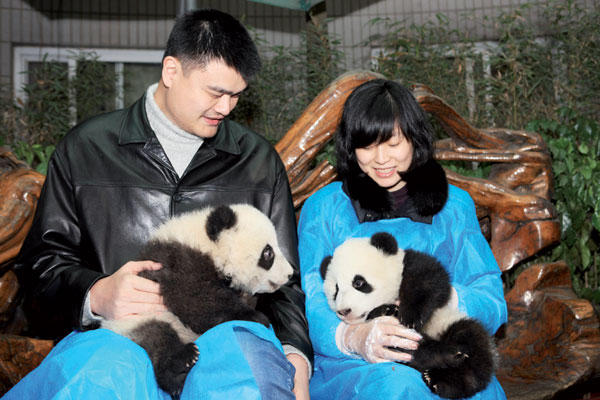Valley leads pandas to the wild
Updated: 2012-01-12 08:01
By Huang Zhiling (China Daily)
|
||||||||
|
Yao Ming and his wife, Ye Li, visit the Chengdu Research Base of Giant Panda Breeding on Wednesday to mark the launch of its program for a large-scale release of captive pandas into the wild. [Shi Yi / for China Daily] |
Chengdu base planning to prepare over 100 pandas for survival in hills
CHENGDU - Yao Ming was relaxed while visiting the nursery in the Chengdu Research Base of Giant Panda Breeding in this capital of Sichuan province, on Wednesday afternoon.
Holding one small panda after another, he kept smiling and saying: "They are so cute."
The former NBA star visited the Chengdu base after participating in the opening ceremony for Panda Valley in Dujiangyan, a city under the administration of Chengdu, in the morning.
The valley, a controlled wilderness designed to train pandas before sending them into the wild, was formally opened to six pandas on Wednesday in Yutang, a town in Dujiangyan.
Yutang was where the first wild panda was found after the People's Republic of China was established in 1949.
In January 1953, the panda was found in the town and sent to an animal farm at the Chengdu Zoo on Futou Hill in northern Chengdu, the site of the present-day Chengdu Research Base of Giant Panda Breeding. This marked the beginning of panda conservation in China.
Covering nearly 134 hectares, the valley, created with a total investment of 300 million yuan ($48 million), can prepare 30 to 40 pandas for life in the wild.
Thirty to 40 pandas will follow the first six before the program is gradually extended to all the pandas in the Chengdu base, which plans to increase the number of pandas to 120 to 150 in 10 years, according to Zhang Zhihe, chief of the research base.
The first six pandas were relocated on Wednesday morning from Zhang's base to the valley, about 50 km from Chengdu.
The two males and four females born between 2007 and 2009 are still immature. They grow rapidly, are bold and have strong ability to adapt to the environment. The Chengdu base has spent nearly a year choosing them from its 108 pandas based on their pedigree, health, genetic background and gender ratio.
"They will spend increasingly less time with humans, including their breeders, before their release and will feed on bamboo instead of dietary supplements. They will live in the valley without many buildings and where bamboo is distributed in different parts so that they must move around to look for food and enhance their physical strength," said Huang Xiangming, head of the animal management department of the base.
"We have spent five decades saving pandas from extinction and have lived with them peacefully. We will spend another five decades or more time sending them to the wild, rather than keeping them in captivity," Zhang said.
In the 1970s and 1980s, 108 pandas perished in China as a result of the blossoming of bamboo, which affects the bamboo leaves that the pandas depend on. Zhang's base was set up in 1987 to house six sick and hungry pandas rescued from the wild.
Thanks to the joint efforts of several generations of researchers, the base has solved the main difficulties in panda breeding, and it has 108 captive pandas, boasting the biggest captive panda population in the world, Zhang said.
"It was difficult for pandas to be ruttish. It was difficult for them to be pregnant, and it was difficult for their cubs to survive. These were the three difficulties in panda breeding," he said.
Coupled with the population growth is the risk of cross-infection of contagious diseases as the pandas are densely populated in his base. In addition, urbanization has an adverse effect on its surrounding environment.
To find an alternative, the base decided to build the valley in 2006 with the support of the central government.
In May 2010, the groundbreaking ceremony was held and its first phase was completed last month.

 Relief reaches isolated village
Relief reaches isolated village
 Rainfall poses new threats to quake-hit region
Rainfall poses new threats to quake-hit region
 Funerals begin for Boston bombing victims
Funerals begin for Boston bombing victims
 Quake takeaway from China's Air Force
Quake takeaway from China's Air Force
 Obama celebrates young inventors at science fair
Obama celebrates young inventors at science fair
 Earth Day marked around the world
Earth Day marked around the world
 Volunteer team helping students find sense of normalcy
Volunteer team helping students find sense of normalcy
 Ethnic groups quick to join rescue efforts
Ethnic groups quick to join rescue efforts
Most Viewed
Editor's Picks

|

|

|

|

|

|
Today's Top News
Health new priority for quake zone
Xi meets US top military officer
Japan's boats driven out of Diaoyu
China mulls online shopping legislation
Bird flu death toll rises to 22
Putin appoints new ambassador to China
Japanese ships blocked from Diaoyu Islands
Inspired by Guan, more Chinese pick up golf
US Weekly

|

|







